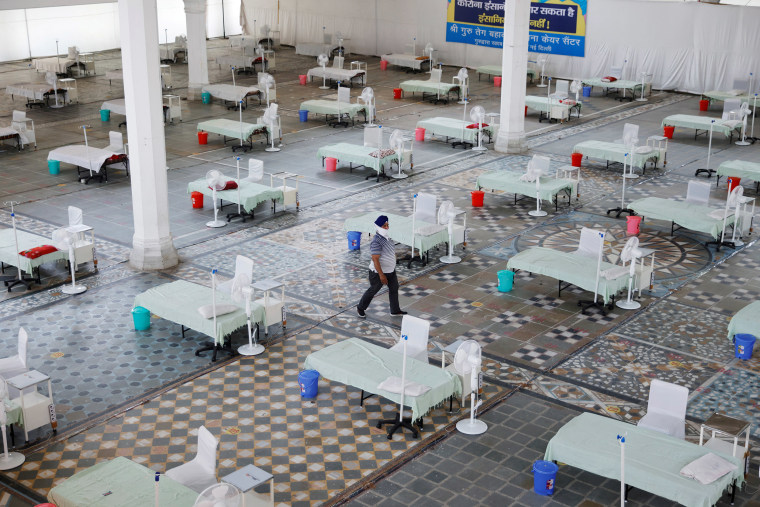The situation in India isn't as bad as it is made out to be so don't worry too much about it.
The death rate is already on the way down without ever reaching the same heights as countries such as the UK, Spain, Italy etc.
Here's the latest graph. Again the aim is to put things in the correct perspective.
View attachment 110569
Wrong. Again. You have now hit 0 for 200 fails. Clap clap clap
https://www.nbcnews.com/news/world/...nges-india-s-covid-death-toll-passes-n1267059
Bodies found floating in the Ganges as India's Covid death toll passes 250,000
The central government is investigating the unidentified bodies, which are suspected to belong to Covid-19 patients.
The bodies of dozens of suspected Covid victims have been found floating in the banks of the Ganges river as hospitals and crematoriums across India remain overwhelmed by the country's rampant second wave of Covid-19.
Officials in the East Indian state of Bihar said in a statement Tuesday that at least 71 corpses washed up in the city of Buxar, adding that they were likely coming from India’s most populous state, Uttar Pradesh. Similarly, officials in Uttar Pradesh said Tuesday that dozens of bloated and decomposed bodies were found on their side of the Ganges river in the district of Ghazipur.
Gajendra Singh Shekhawat, minister of water resources, said in a tweet Tuesday that the central government is seeking an investigation of the unidentified bodies, which are suspected to belong to Covid-19 patients. He added that the unidentified bodies will be cremated as per the government’s Covid-safety protocols.

People wait in a line to refill oxygen cylinders for Covid-19 patients at a refilling center in New Delhi in May.auseef Mustafa / AFP - Getty Images
In India's capital, New Delhi, ashes of dead Covid-19 patients are going unclaimed, according to Reuters.
Recommended

WORLDMounting violence leaves dozens dead and world fearing war between Israel, Gaza

CORONAVIRUSU.K.'s Johnson announces Covid-19 public inquiry
A report by the Press Trust of India on Monday found that people are abandoning bodies of Covid-19 victims in fear of catching the infection themselves.
India posted a record number of Covid-19 deaths Wednesday, bringing the total number of deaths to 254,197 and its overall cases to over 23 million, only second after the U.S., according to Health Ministry data.
However, the number is thought to be a vast undercount, with experts warning the real figures may be five to 10 times higher in the country of over 1.3 billion people.
Volunteer Ankit Gupta, who has been supporting lower-income families, migrant workers and the homeless in Delhi by providing them medical supplies and meals, said that the number of deaths in the capital are severely underreported.
“Many of the people I have tried to help, they unfortunately died at home,” he said. “There are people who are not getting ICU beds at hospitals, these deaths are not registered in the official figures.”
Across India, several states have been imposing localized lockdowns. Prime Minister Narendra Modi’s government continues to face pressure to announce a nationwide lockdown to curb the spread of the virus.
India has opened vaccinations to all adults this month in an attempt to contain the surge in cases, however, many Indian states have seen shortages in vaccine stocks.

Beds are seen inside a Gurudwara converted into a Covid-19 care facility in New Delhi, India, in May.Adnan Abidi / Reuters
India is administering two homegrown vaccines: Covishield, made by the Serum Institute, and Covaxin, made by Bharat Biotech. Both companies have struggled to meet increasing demand.
In a press conference Wednesday, Delhi’s deputy chief minister, Manish Sisodia, said that the capital had run out of its reserve stock of vaccines, forcing the city to shut down more than 100 centers administering Covaxin.
However, a glaring hesitancy to get vaccinated remains apparent in India. Volunteer Gupta said: "The correct information about the vaccination is not reaching people via the government, that’s why there’s a lack of trust factor and many people are not registering for the vaccine.”
He also found that migrant workers and the poor were being overlooked in the country’s vaccination attempts. “These vaccines are only for the privileged people or the tech-savvy, what about those people who don’t have mobile phones or internet connections? How will they get the vaccine?”
As India continues to grapple with its second wave, the World Health Organization on Monday classified the coronavirus variant identified in India last year as a “variant of concern at a global level.”
“There is some available information to suggest increased transmissibility,” they said, adding that the variant had already spread to more than 30 countries.
Countries neighboring India are also facing a surge in fresh Covid-19 infections, including Nepal, Sri Lanka, Maldives and Pakistan. This has sparked fears of the virus running rampant across South Asia in the coming months.


